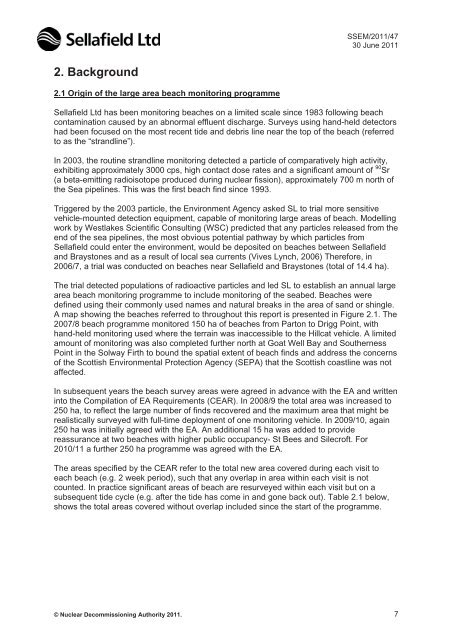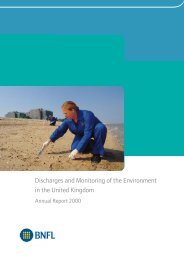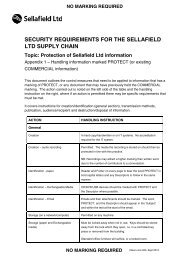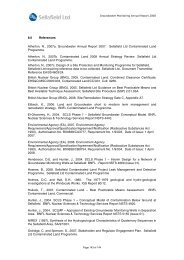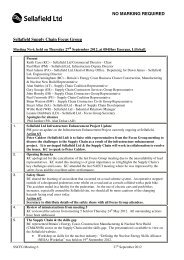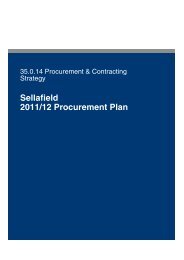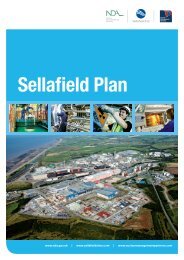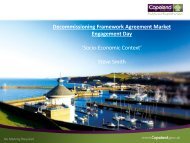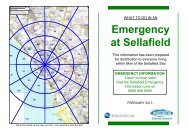Annual Report for 2010/11 and Forward Programme - Sellafield Ltd
Annual Report for 2010/11 and Forward Programme - Sellafield Ltd
Annual Report for 2010/11 and Forward Programme - Sellafield Ltd
You also want an ePaper? Increase the reach of your titles
YUMPU automatically turns print PDFs into web optimized ePapers that Google loves.
SSEM/20<strong>11</strong>/4730 June 20<strong>11</strong>2. Background2.1 Origin of the large area beach monitoring programme<strong>Sellafield</strong> <strong>Ltd</strong> has been monitoring beaches on a limited scale since 1983 following beachcontamination caused by an abnormal effluent discharge. Surveys using h<strong>and</strong>-held detectorshad been focused on the most recent tide <strong>and</strong> debris line near the top of the beach (referredto as the “str<strong>and</strong>line”).In 2003, the routine str<strong>and</strong>line monitoring detected a particle of comparatively high activity,exhibiting approximately 3000 cps, high contact dose rates <strong>and</strong> a significant amount of 90 Sr(a beta-emitting radioisotope produced during nuclear fission), approximately 700 m north ofthe Sea pipelines. This was the first beach find since 1993.Triggered by the 2003 particle, the Environment Agency asked SL to trial more sensitivevehicle-mounted detection equipment, capable of monitoring large areas of beach. Modellingwork by Westlakes Scientific Consulting (WSC) predicted that any particles released from theend of the sea pipelines, the most obvious potential pathway by which particles from<strong>Sellafield</strong> could enter the environment, would be deposited on beaches between <strong>Sellafield</strong><strong>and</strong> Braystones <strong>and</strong> as a result of local sea currents (Vives Lynch, 2006) There<strong>for</strong>e, in2006/7, a trial was conducted on beaches near <strong>Sellafield</strong> <strong>and</strong> Braystones (total of 14.4 ha).The trial detected populations of radioactive particles <strong>and</strong> led SL to establish an annual largearea beach monitoring programme to include monitoring of the seabed. Beaches weredefined using their commonly used names <strong>and</strong> natural breaks in the area of s<strong>and</strong> or shingle.A map showing the beaches referred to throughout this report is presented in Figure 2.1. The2007/8 beach programme monitored 150 ha of beaches from Parton to Drigg Point, withh<strong>and</strong>-held monitoring used where the terrain was inaccessible to the Hillcat vehicle. A limitedamount of monitoring was also completed further north at Goat Well Bay <strong>and</strong> SouthernessPoint in the Solway Firth to bound the spatial extent of beach finds <strong>and</strong> address the concernsof the Scottish Environmental Protection Agency (SEPA) that the Scottish coastline was notaffected.In subsequent years the beach survey areas were agreed in advance with the EA <strong>and</strong> writteninto the Compilation of EA Requirements (CEAR). In 2008/9 the total area was increased to250 ha, to reflect the large number of finds recovered <strong>and</strong> the maximum area that might berealistically surveyed with full-time deployment of one monitoring vehicle. In 2009/10, again250 ha was initially agreed with the EA. An additional 15 ha was added to providereassurance at two beaches with higher public occupancy- St Bees <strong>and</strong> Silecroft. For<strong>2010</strong>/<strong>11</strong> a further 250 ha programme was agreed with the EA.The areas specified by the CEAR refer to the total new area covered during each visit toeach beach (e.g. 2 week period), such that any overlap in area within each visit is notcounted. In practice significant areas of beach are resurveyed within each visit but on asubsequent tide cycle (e.g. after the tide has come in <strong>and</strong> gone back out). Table 2.1 below,shows the total areas covered without overlap included since the start of the programme.© Nuclear Decommissioning Authority 20<strong>11</strong>. 7


